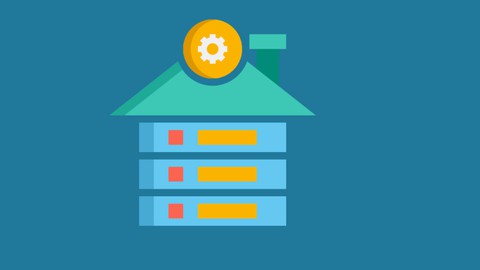
Data Warehouse & Power BI For Beginners -DW ,SSIS, ETL, BI
Data Warehouse & Power BI For Beginners -DW ,SSIS, ETL, BI, available at $59.99, has an average rating of 3.75, with 93 lectures, based on 90 reviews, and has 6407 subscribers.
You will learn about Describe the key elements of a data warehousing solution Describe the main hardware considerations for building a data warehouse Implement a logical design for a data warehouse Implement a physical design for a data warehouse Create columnstore indexes Implementing a MS SQL Server Data Warehouse Describe the key features of SSIS Implement a data flow by using SSIS Implement control flow by using tasks and precedence constraints Create dynamic packages that include variables and parameters Debug SSIS packages Describe the considerations for implement an ETL solution Implement Data Quality Services Deploy SSIS projects Implement a Master Data Services model Describe how you can use custom components to extend SSIS Describe BI and common BI scenarios Create a data warehouse with Microsoft SQL Server Implement ETL with SQL Server Integration Services validate and cleanse data with SQL Server Data Quality Services and SQL Server Master Data Services. This course is ideal for individuals who are Database professionals or Business Analyst professionals or Data Engineering professionals It is particularly useful for Database professionals or Business Analyst professionals or Data Engineering professionals.
Enroll now: Data Warehouse & Power BI For Beginners -DW ,SSIS, ETL, BI
Summary
Title: Data Warehouse & Power BI For Beginners -DW ,SSIS, ETL, BI
Price: $59.99
Average Rating: 3.75
Number of Lectures: 93
Number of Published Lectures: 93
Number of Curriculum Items: 93
Number of Published Curriculum Objects: 93
Original Price: $89.99
Quality Status: approved
Status: Live
What You Will Learn
- Describe the key elements of a data warehousing solution
- Describe the main hardware considerations for building a data warehouse
- Implement a logical design for a data warehouse
- Implement a physical design for a data warehouse
- Create columnstore indexes
- Implementing a MS SQL Server Data Warehouse
- Describe the key features of SSIS
- Implement a data flow by using SSIS
- Implement control flow by using tasks and precedence constraints
- Create dynamic packages that include variables and parameters
- Debug SSIS packages
- Describe the considerations for implement an ETL solution
- Implement Data Quality Services
- Deploy SSIS projects
- Implement a Master Data Services model
- Describe how you can use custom components to extend SSIS
- Describe BI and common BI scenarios
- Create a data warehouse with Microsoft SQL Server
- Implement ETL with SQL Server Integration Services
- validate and cleanse data with SQL Server Data Quality Services and SQL Server Master Data Services.
Who Should Attend
- Database professionals
- Business Analyst professionals
- Data Engineering professionals
Target Audiences
- Database professionals
- Business Analyst professionals
- Data Engineering professionals
A data warehouse is a type of data management system that is designed to enable and support business intelligence (BI) activities, especially analytics. Data warehouses are intended to perform queries and analysis and often contain large amounts of historical data. The data within a data warehouse is usually derived from a wide range of sources such as application log files and transaction applications.
A data warehouse centralizes and consolidates large amounts of data from multiple sources. Its analytical capabilities allow organizations to derive valuable business insights from their data to improve decision-making. Over time, it builds a historical record that can be invaluable to data scientists and business analysts. Because of these capabilities, a data warehouse can be considered an organization’s “single source of truth.”
Data warehouses offer the overarching and unique benefit of allowing organizations to analyze large amounts of variant data and extract significant value from it, as well as to keep a historical record.
A typical data warehouse often includes the following elements:
-
A relational database to store and manage data
-
An extraction, loading, and transformation (ELT) solution for preparing the data for analysis
-
Statistical analysis, reporting, and data mining capabilities
-
Client analysis tools for visualizing and presenting data to business users
-
Other, more sophisticated analytical applications that generate actionable information by applying data science and artificial intelligence (AI) algorithms, or graph and spatial features that enable more kinds of analysis of data at scale.
Power BI is a collection of software services, apps, and connectors that work together to turn your unrelated sources of data into coherent, visually immersive, and interactive insights. Your data may be an Excel spreadsheet, or a collection of cloud-based and on-premises hybrid data warehouses. Power BI lets you easily connect to your data sources, visualize and discover what’s important, and share that with anyone or everyone you want.
Power BI consists of several elements that all work together, starting with these three basics:
-
A Windows desktop application called Power BI Desktop.
-
An online SaaS (Software as a Service) service called the Power BI service.
-
Power BI mobile apps for Windows, iOS, and Android devices.
Course Curriculum
Chapter 1: Microsoft SQL Server Setup
Lecture 1: Introduction
Lecture 2: Please Read
Lecture 3: What is SQL Server
Lecture 4: SQL Server Editions
Lecture 5: Hardware | Software Requirements
Lecture 6: SQL Server Download
Lecture 7: SQL Server Installation
Lecture 8: Install SSMS
Lecture 9: SQL Server Configuration Manager
Lecture 10: Connecting SSMS to SQL Server
Lecture 11: Database Concepts
Chapter 2: Installing Sample Databases
Lecture 1: Installing Adventureworks 2014
Lecture 2: Installing Adventureworks 2016
Lecture 3: Installing AdventureworksDW 2016
Lecture 4: Installing World Wide Importers
Lecture 5: Installing World Wide ImportersDW
Lecture 6: SQL Server Data Files
Chapter 3: Microsoft Visual Studio Setup
Lecture 1: What is Visual Studio
Lecture 2: Minimum Installation Requirements
Lecture 3: Installing Visual Studio
Lecture 4: visual Studio workloads
Lecture 5: Install SQL Server Data Tools
Lecture 6: Installing SSDT Templates
Chapter 4: Introduction to Data Warehousing
Lecture 1: What is Data Warehouse
Lecture 2: Data Warehouse vs Enterprise Data Warehouse
Lecture 3: Data Warehouse Vs Database
Chapter 5: Data Warehouse Requirements
Lecture 1: Hardware Requirements
Lecture 2: Enabling SQL Server Agent
Lecture 3: Database Configurations
Lecture 4: FTDW Sizing Tool ( Already Downloaded)
Lecture 5: FTDW Sizing Tool
Chapter 6: Designing a Data Warehouse
Lecture 1: Logical Design of Data Warehouse
Lecture 2: Physical Design of Data Warehouse – Part 1
Lecture 3: Physical Design of Data Warehouse -Part 2
Lecture 4: Designing Dimension Tables
Chapter 7: Creating an ETL Solution
Lecture 1: What is ETL
Lecture 2: What is SSIS
Lecture 3: Introduction to ETL with SSIS
Lecture 4: Creating a new SSIS Project
Lecture 5: Exploring Source Data : Part 1
Lecture 6: Exploring Source Data : Part 2
Chapter 8: Implementing Control Flow & Data flow in an SSIS Package
Lecture 1: Introduction to control flow: Part 1
Lecture 2: Introduction to control flow: Part 2
Lecture 3: Implementing data flow – Part 1
Lecture 4: Implementing data flow – Part 2
Chapter 9: Debugging and Troubleshooting SSIS Packages
Lecture 1: Debugging SSIS Package : Part 1
Lecture 2: Debugging SSIS Package : Part 2
Lecture 3: Logging SSIS Package Events
Lecture 4: Handling errors in an SSIS Package
Chapter 10: Implementing an Incremental ETL Process
Lecture 1: Introduction to incremental ETL Process
Lecture 2: Extracting modified data: Part 1
Lecture 3: Extracting modified data: Part 2
Lecture 4: Extracting modified data: Part 3
Lecture 5: Extracting modified data: Part 4
Lecture 6: Loading modified data: Part 1
Lecture 7: Loading modified data: Part 2
Lecture 8: Working with changing dimensions
Chapter 11: Deploying and Configuring SSIS Packages
Lecture 1: Integration services catalogs
Lecture 2: Deploying SSIS Solutions
Lecture 3: Execute a package with SQL Server Agent
Lecture 4: Configuring advanced SSIS Settings
Chapter 12: Enforcing Data Quality in Data Warehouse
Lecture 1: Installing Data Quality Services
Lecture 2: Cleansing data with data quality services
Lecture 3: Find duplicate data : Part 1
Lecture 4: Find duplicate data : Part 2
Lecture 5: Using data quality services in SSIS data flow
Chapter 13: Consuming Data in a Data Warehouse
Lecture 1: Introduction to Business Intelligence
Lecture 2: Creating a new SSRS Project in VS 2019
Lecture 3: Using SSRS in Data Warehouse: Part 1
Lecture 4: Using SSRS in Data Warehouse: Part 2
Lecture 5: Creating a new SSAS Project
Lecture 6: Data Analysis with SSAS : Part 1
Lecture 7: Data Analysis with SSAS : Part 2
Chapter 14: Microsoft Power BI Setup
Lecture 1: Office 365 Setup
Lecture 2: What is Power BI
Lecture 3: What is Power BI Desktop
Lecture 4: Installing Power BI Desktop
Lecture 5: Power BI Desktop Tour
Chapter 15: Power BI Overview
Lecture 1: Power BI Overview : Part 1
Lecture 2: Power BI Overview : Part 2
Lecture 3: Power BI Overview : Part 3
Lecture 4: Components of Power BI
Lecture 5: Building blocks of Power BI
Lecture 6: Exploring Power BI Desktop Interface
Lecture 7: Exploring Power BI Service
Instructors
-
Bluelime Learning Solutions
Making Learning Simple
Rating Distribution
- 1 stars: 3 votes
- 2 stars: 3 votes
- 3 stars: 16 votes
- 4 stars: 28 votes
- 5 stars: 40 votes
Frequently Asked Questions
How long do I have access to the course materials?
You can view and review the lecture materials indefinitely, like an on-demand channel.
Can I take my courses with me wherever I go?
Definitely! If you have an internet connection, courses on Udemy are available on any device at any time. If you don’t have an internet connection, some instructors also let their students download course lectures. That’s up to the instructor though, so make sure you get on their good side!
You may also like
- Best Video Editing Courses to Learn in February 2025
- Best Music Production Courses to Learn in February 2025
- Best Animation Courses to Learn in February 2025
- Best Digital Illustration Courses to Learn in February 2025
- Best Renewable Energy Courses to Learn in February 2025
- Best Sustainable Living Courses to Learn in February 2025
- Best Ethical AI Courses to Learn in February 2025
- Best Cybersecurity Fundamentals Courses to Learn in February 2025
- Best Smart Home Technology Courses to Learn in February 2025
- Best Holistic Health Courses to Learn in February 2025
- Best Nutrition And Diet Planning Courses to Learn in February 2025
- Best Yoga Instruction Courses to Learn in February 2025
- Best Stress Management Courses to Learn in February 2025
- Best Mindfulness Meditation Courses to Learn in February 2025
- Best Life Coaching Courses to Learn in February 2025
- Best Career Development Courses to Learn in February 2025
- Best Relationship Building Courses to Learn in February 2025
- Best Parenting Skills Courses to Learn in February 2025
- Best Home Improvement Courses to Learn in February 2025
- Best Gardening Courses to Learn in February 2025






















